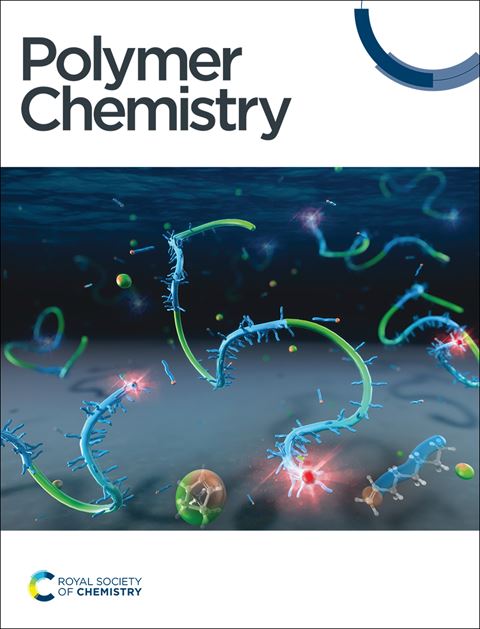使用芳香族硫醇在室温下快速、无催化剂地生产不含异氰酸酯的聚氨酯泡沫塑料
IF 4.1
2区 化学
Q2 POLYMER SCIENCE
引用次数: 0
摘要
聚羟基聚氨酯(PHU)类非异氰酸酯聚氨酯(NIPU)泡沫有望成为主导泡沫市场的传统异氰酸酯类聚氨酯的绿色替代品。最近,PHU 配方的环状碳酸酯同时进行有机催化氨解和 S-烷基化,为生产二氧化碳自发泡 PHU 泡沫提供了一种简便的方法。然而,这种工艺仅限于生产 Tg 较低的泡沫(通常可达室温),而且在 120 °C 下发泡速度较慢(即 30 分钟),因此与工业发泡设备所需的发泡时间(1-10 分钟)和室温(r.T.)相去甚远。在这项工作中,我们详细阐述了加速硫醇辅助 NIPU 发泡的策略,以便在无催化剂条件下,在 5-10 分钟内完成反应配方的室温发泡。具体方法是用酸性更强的芳香族硫醇取代脂肪族硫醇,并添加环氧化物作为热释放促进剂,从而加快发泡和固化速度。此外,通过选择胺类共聚单体和环氧化物添加剂,还可以轻松获得柔性、半刚性和刚性泡沫。这项研究提出了加快自发泡 NIPU 工艺的一般和简单概念,这是降低能耗和生产成本的关键一步,为现有泡沫生产厂的改造提供了可能性。本文章由计算机程序翻译,如有差异,请以英文原文为准。

Fast, catalyst-free room temperature production of isocyanate-free polyurethane foams using aromatic thiols†
Non-isocyanate polyurethane (NIPU) foams of the polyhydroxyurethane (PHU) type are promising greener alternatives to their conventional isocyanate-based polyurethane counterparts that dominate the foam market. Recently, concomitant organocatalyzed aminolysis and S-alkylation of the cyclic carbonates of PHU formulations offered a facile route to produce CO2 self-blown PHU foams. However, this process was limited to the production of foams of rather low Tg (commonly up to room temperature) and suffered from slow foaming (i.e. 30 min) at 120 °C, thus still far from the foaming timeframes (1–10 min) and room temperature (r.t.) needed for adaptation to industrial foaming equipment. In this work, we elaborate strategies to accelerate thiol-assisted NIPU foaming in order for it to be complete in 5–10 minutes from r.t. reactive formulations under catalyst-free conditions. This is achieved by substituting aliphatic thiols by more acidic aromatic ones, and by adding epoxides as heat release promotors that will accelerate both the foaming and the curing rates. Moreover, flexible, semi-rigid and rigid foams are easily accessible by the choice of the amine comonomer and epoxide additive. This work draws general and simple concepts for greatly speeding-up the self-blowing NIPU process, a crucial step toward decreasing the energetic and production costs, offering potential for retrofitting existing foam production plants.
求助全文
通过发布文献求助,成功后即可免费获取论文全文。
去求助
来源期刊

Polymer Chemistry
POLYMER SCIENCE-
CiteScore
8.60
自引率
8.70%
发文量
535
审稿时长
1.7 months
期刊介绍:
Polymer Chemistry welcomes submissions in all areas of polymer science that have a strong focus on macromolecular chemistry. Manuscripts may cover a broad range of fields, yet no direct application focus is required.
 求助内容:
求助内容: 应助结果提醒方式:
应助结果提醒方式:


